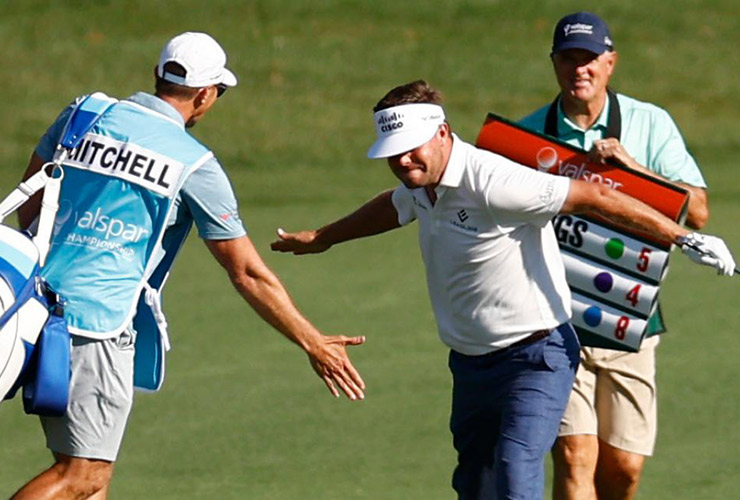“It’s called The Snake Pit for a reason.” Those were the words of Keith Mitchell on Saturday afternoon after he’d played the third round of the Valspar Championship on the Innisbrook Copperhead Course. If you’re saying something like that, it’s probably a rationalization for having been hammered by the final three holes that are dubbed Mocassin, Rattler and Copperhead.
As corny as the name may be, it’s legitimately brutal. According to the PGA Tour, The Snake Pit is the third-toughest three-hole stretch to end any tournament course. Since 2000, the Pit has played a combined 4.978 over par when the other 15 holes score at plus-2.6.
And here’s the number to keep in mind when it comes to Mitchell’s day: Only two players—Mark Brooks (2002) and Vijay Singh (2004)—have played The Snake Pit at five under par for the week, and seven golfers have scored three under in any one round.
That all makes what Mitchell pulled off ridiculously impressive, as the 32-year-old veteran birdied the par-4 16th and par-3 17th, and then launched a 7-iron from 159 yards at the par-4 18th. The ball took one hop before going into the cup for the rarest of eagles. With that string, Mitchell became the first player ever to shoot four under at The Snake Pit—a feat that likely will never be matched.
An eagle hole-out to take the solo lead!
@K_m_Mitchell is the first player in tournament history to play the Snake Pit (Nos. 16-18) in 4-under par @ValsparChamp. pic.twitter.com/EWrfSoY918— PGA TOUR (@PGATOUR) March 23, 2024
Making it all the better was that Mitchell was in the thick of the chase, and the 2 at 18 contributed to a six-under 29 on the back and a full-round 66 that pushed him into a two-shot lead at 10 under. Mitchell is trying to win his second title in 170 tour starts, with his lone win coming also in Florida, at the 2019 Honda Classic.
In watching the replay of his final shot afterwards, Mitchell had to laugh because right after he hit the shot, he got something in his eye that he was trying to wipe away. He didn’t know what happened until hearing the roar of the crowd. Mitchell called making an eagle at the finisher “out of control.”
“Obviously, some luck involved in that, but the good thing is I executed all the shots I wanted to,” Mitchell said. “That’s really all I could do. I could have hit those same shots and made three pars and been just as happy. So, honestly, if I hit the shots like I hit coming down the stretch tomorrow I’ll have a chance. Because I hit ‘em all where I wanted to.”
The swings Mitchell took earlier in his stretch were just as impressive as the last.
At the 16th, he hit 5-wood off the tee and then 9-iron to get to 13 feet and drained the putt. “The first really good putt I made all day of really substantial length,” said Mitchell, who was one over in the round through the first 11 holes.
The par-3 17th, where 57 percent of players are over par for their careers, Mitchell was between clubs and chose to take 20 yards off his 6-iron from 177. He rifled it to near tap-in range.
Then, again at 18, Mitchell decided to take another 25 yards off his 7-iron from 159 and got the fortunate hop.
Those last couple of approaches were the satisfying evidence for the work Mitchell has put in to go beyond simply hitting his irons at “stock” distances. In looking at his stats from last season, his iron play was so lacking that he ranked 160th in strokes gained/approach, losing about one-quarter shot a round. It’s a stat even harder to swallow when Mitchell ranked seventh in SG/off-the-tee.
“That’s just unacceptable out here,” Mitchell said. “Especially when I feel like I have the technique to do it if I can hit my driver like I do. So, it was all distance control. I learned that, fortunately. I hate that it took this long, but it’s better late than never.”
The work began in earnest at January’s The American Express, where he notched a tie for ninth. “I started working on my distance control on the driving range instead of just my golf swing,” Mitchell explained. “It’s really paid off.”
Mitchell has missed only one cut since the AmEx, and his strong Florida play continued early in March with another T-9 in the Cognizant Classic, where he closed with a 65.
He’d take anything close to that on Sunday, where The Snake Pit and its coiled statue wait for a payback strike.
Image: Douglas P. DeFelice









